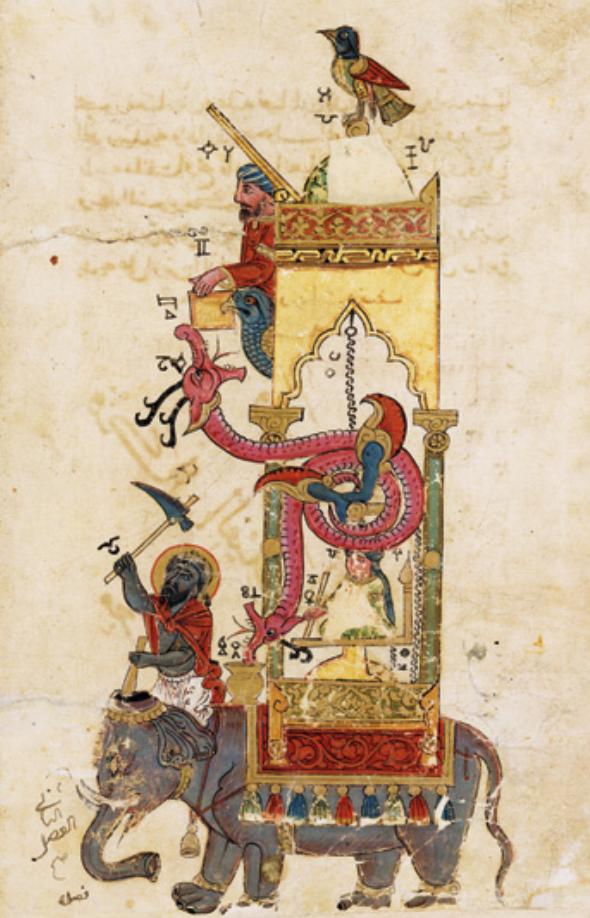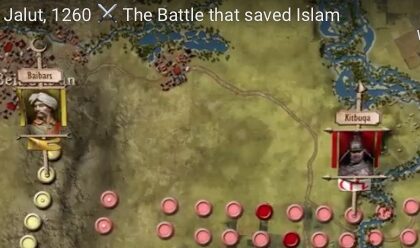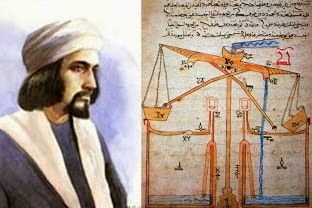The Father of Robotics

Father of robotics?
Iowa State University
University Library
Oct 10, 2007
Do you know who is considered to be the “father of robotics?” The word “robotics” was first coined by Isaac Asimov in 1941 but the concept has been around much longer. If you are thinking Leonardo da Vinci, you are close. Drawings left by Leonardo made around 1495, depict the first recorded designs of a humanoid robot but someone else got there before him. Concepts akin to a robot can be found as long ago as the 4th century BC when the Greek mathematician Archytas of Tarentum postulated a mechanical bird he called “The Pigeon” which was propelled by steam. The first person to actually build a programmable humanoid robot was Al-Jazari in 1206.
According to Wikipedia, Ibn Ismail ibn al-Razzaz Jazari (in Arabic: ![]() a.k.a. Al-Jazari) was an Arab Muslim scholar, inventor, and mechanical engineer during the Islamic Golden Age (Middle Ages). While his birth and death dates vary with almost every article written about him, other details about his life and work are better known. Al-Jazari is not only known as the “father of robotics” he also documented 50 mechanical inventions (along with construction drawings) and is considered to be the “father of modern-day engineering.” The inventions he mentions in his book include the crank mechanism, connecting rod, programmable automaton, a humanoid robot, reciprocating piston engine, suction pipe, suction pump, double-acting pump, valve, combination lock, cam, camshaft, segmental gear, the first mechanical clocks driven by water and weights, and especially the crankshaft, which is considered the most important mechanical invention in history after the wheel. Not bad for a guy who lived 800 years ago!
a.k.a. Al-Jazari) was an Arab Muslim scholar, inventor, and mechanical engineer during the Islamic Golden Age (Middle Ages). While his birth and death dates vary with almost every article written about him, other details about his life and work are better known. Al-Jazari is not only known as the “father of robotics” he also documented 50 mechanical inventions (along with construction drawings) and is considered to be the “father of modern-day engineering.” The inventions he mentions in his book include the crank mechanism, connecting rod, programmable automaton, a humanoid robot, reciprocating piston engine, suction pipe, suction pump, double-acting pump, valve, combination lock, cam, camshaft, segmental gear, the first mechanical clocks driven by water and weights, and especially the crankshaft, which is considered the most important mechanical invention in history after the wheel. Not bad for a guy who lived 800 years ago!
Al-Jazari also noted a number of practical joke devices in his text. Some were trick drinking vessels that appeared to contain water but could not be emptied. Others looked empty but produced water when tipped over.
The History Channel is currently running “Ancient Discoveries: Machines of the East” which includes information about Al-Jazari. A DVD of this program can be checked out in the Parks Library Media Center or you can check the program listings to see when it is slated to re-run: http://www.thehistorychannel.co.uk/site/tv_guide/listings
The Parks Library also has the following related books:
The Book of Knowledge of Ingenious Mechanical Devices(this is a translation of Al-Jazari’s original text written in 1206)
Call number: TJ144 .J3913 1974
Science and Its Times: Understanding the Social Significance of Scientific Discovery (volume 2 has information on Al-Jazari)
Call number: Q175.46 S35 2000
A History of Engineering in Classical and Medieval Times
Call number: TA15 H54x, 1984
Wikipedia article at: http://en.wikipedia.org/wiki/Al-Jazari
Full-text access to the Government Reports
The DARTS (Depository Access to Reports Technical & Scientific) database from the National Technical Information Service (NTIS) provides full-text access to approximately 240,000 documents published in 1964-2000 from a wide variety of government agencies. NTIS publishes reports in almost every subject area, science, social sciences, and even some in the humanities. All projects funded with U.S. Government research monies are required to have some sort of published report available. The vast majority of these are available through NTIS. DARTS is a beta project to make the scientific reports available full-text online.
DARTS is currently in beta test and is only accessible from within the Parks Library – and requires a user id and password to access it. To access this database, please inquire at the Parks Library Help & Information Desk.
Food Chemical Codex 5th edition [electronic resource]

The Library has obtained electronic access to the latest edition of the Food Chemical Codex. This tool has been published by the National Academy of Sciences; however, future editions will be published by United States Pharmacopeia (USP). The Food Chemical Codex (FCC) is a compendium of standards that promote the quality and safety of food additives such as nutrients, preservatives, flavorings, and colorings. The FCC was developed in the late 1950’s following passage of the 1958 Food Additives amendment to the federal Food, Drug, and Cosmetic Act. It was updated in 1966, 1972, 1981, 1996, and 2003. The fifth edition and its supplements represent a comprehensive revision with substantial changes in specifications for heavy metal limits, particularly of lead. This edition features 52 new entries on food additives and 48 new entries on flavoring agents. Each entry provides a physical description of the substance and its uses in foods, lists its purity requirements, describes the appropriate tests to determine compliance, and provides packaging and storage guidelines. To access this electronic book – go to:
http://www.lib.iastate.edu/collections/jourbook/etext_name.html
Designing new Da Vinci robot-making in 1478, it was a new form of design on paper. Meanwhile, Muslims are very brilliant engineer Al-Jazari, has succeeded in designing and creating various forms of robots in the early 13th century AD For this reason, modern science community dubbed as ” Mr. Robot ”. Islamic civilization more advanced three centuries in the West than the robotic technology.
Islamic civilization is a pioneer in the field of technology automata, which is a machine that can run its own (self-operating). Automata are often used to describe a robot or autonomous robots more specifically. The word comes from the Greek Automata automatos, which applies to the will of his own, moving on its own.
The word was used to describe the machinery moving non-electronic, specifically designed to resemble human or animal movement. Engine robots created by Al-Jazari in the form of a boat that is floating in a lake carrying four robotic music player.
Robot consisting of two drummers, a blowing harp, and flute player metal was created to entertain the royal guests in banquet drink. Al-Jazari developed the principles of hydraulics to move the machine that became known as robotic machine. ” It is the first that can be programmed automata, ” said Professor Noel Sharkey.
Robot drummer Al-Jazari assembled can play a variety of different rhythms. Robots are found Al-Jazari also invite admiration of Charles B Fowler. According to him, the findings of the Muslim engineers can be called ” robot band ”. An important achievement that has never been discovered earlier civilizations and cultures in ancient times.
In particular, Mark E Rosheim concluded, the progress achieved in the era of the triumph of the Islamic world in the field of robotics as a discovery is more advanced than the Greeks. ” Unlike the Greek design, sample robot created the Islamic world (Arab) capable of inviting appeal. Not only in the dramatic illusion, but is able to present the environment that can make people more comfortable, ” said Rosheim.
According Rosheim, the robot creation of Al-Jazari was one contribution to the Islamic civilization which is very important for the technology. According to him, a robot created by the Islamic civilization in the early 13th century AD already humanoid robots and able to help humans for practical purposes. Unfortunately, he said, the robot was not created for the benefit of the industry.
In addition to ” robot band ”, Al-Jazari also managed to create a human-shaped robot waiter who served for serving water, tea, or other beverages. Beverages stored in a tank with a reservoir (water reservoir). From the reservoir, the water flowed into a bucket and after seven minutes of flowing into a cup. After that, the robot was issued a drink.
Another important discovery in the golden era of Islam that is not less interesting is the automatic hand washing with depletion mechanism. Mechanisms developed Al-Jazari, is now used in a working system of modern toilets. Automatic washing robot hand that shaped woman standing with a basin of water.
When a user hold the lever, water will dry up and the female robot will re-fill the basin with water. Another robot developed Al-Jazari is peacock fountain. This robot serves as a replacement maid or waitress. This allows the robot when cleaning hands, because the robot peacock will offer fiber and towels automatically.
Another robot created Muslim engineers are peacocks can automatically move. Al-Jazari move the robot peacock with hydropower. Other robotic technology found Al-Jazari is an automatic door as part of a one-hour water created.
Automata technology developed Al-Jazari achieve 50 kinds and all written and illustrated in his book that is legendary, Al-Jami al-Ilm Wal Bain ‘Aml al-Nafi Fi rays’ at al-Hiyal (The Book of Knowledge of Ingenious Mechanical Devices ). His work is about the theory and practice of mechanics. In the book, Al-Jazari reveal in detail various issues related to mechanics.
In addition, Al-Jazari also create other automata technology that serves to assist and facilitate the task of man. He, among others, creating household appliances and musical automata powered water power.
All robots are found Islamic civilization through Al-Jazari truly astounding. ” I can not ignore the work of Al-Jazari is so important. In his book, he describes so detailed instruction to design, assemble, and make a machine, ” said British historian, Donald R Hill, in his article titled, Studies in Medieval Islamic Technology.
Other historians are fascinated with the minutes of the discovery of al-Jazari is Lynn White. ” It is clear that the inventor of the first gear is Al-Jazari. West only discovered in 1364 AD ” According to Lynn, said gear (gear) has become the vocabulary or terms in the European engine design in the 16th century AD
In view of Donald Hill, none of the documents that can challenge the work of Al-Jazari until the modern age. According to him, the minutes of the discovery of al-Jazari is so rich in instruction regarding the design, manufacture, and assembly of machines.
” Al-Jazari was only able to combine the techniques of the predecessors of the Arab and non-Arab, but also he is really a creative engineer, ” said Donald Hill who so admire Al-Jazari. Interest on the work of the Muslim engineer, Donald Hill also encouraged and motivated to translate the works of Al-Jazari in 1974.
Al-Jazari Muslim Leader Engineers
Ra’is Al-A’mal. The title ditabalkan Muslim engineers in the 13th century AD to Al-Jazari. No wonder, if the full name of the engineer phenomenal it is al-Shaykh al-Rais Badi al-Zaman Amal Abu al-Izz ibn Ismail ibn al-Razzaz Al-Jazari. Meanwhile, the title Badi al-Zaman and al-Shaykh bears showed that he is a scientist unique, incomparable brilliance, high master of science, and human dignity.
Meanwhile, al-Jazari attached to the full name indicates amsalnya. Al-Jazari family originated from the Arabian Peninsula in Diyar Bakr Ibn Umar, Turkey. However, another hypothesis states that Al-Jazari was born in Al-Jazira, an area located in northern Mesopotamia, a region in northern Iraq and northeastern Syria, exactly between the Tigris and Euphrates.
That’s where Al-Jazari devote his life as an engineer to create a variety of machines. The explorers and travelers away to the region in the 12th century AD, admire prosperity achieved Artukid Dynasty. At the same time, peace and political stability and security so restrained.
As well as his father, Al-Jazari devote himself to the kings of Dynasty Urtuq or Artuqid in Diyar Bakir from 1174 AD to 1200 AD as an engineer. During his life, Al-Jazari experienced three times in succession Artukid Dynasty, namely Nur al-Din Muhammad ibn Arslan (570 H – 581 H / 1174 AD – 1185 AD); Qutb al-Din Muhammad ibn Sukman (681 H – 697 H / 1185 AD – 1200 AD); and Nasir al-Din Mahmud ibn Muhammad (597 H – 619 H / 1200 AD – 1222 AD).
At the request of Nasir al-Din Mahmud, al-Jazari wrote throughout his findings in a treatise that is phenomenal. In the introduction to his treatise, Al-Jazari said that he began to serve Artuqids in 570 AH / 1174 AD He treatise discovery, after 25 years together become engineers under the leadership of the three kings Artuqids.
Based on that information, it can be concluded, the possibility of al-Jazari wrote his treatise in 595 AH / 1198 AD, or two years before Nasir al-Din was asked to become king. According to the Oxford manuscript, Al-Jazari merampumgkam treatise that shook the world of modern techniques on January 16, 1206 M.
Works great Al-Jazari was enhanced by Muhammad ibn Yusuf ibn `Uthman al-Haskafiat at the end of Shaban 602 H / 10 April 1206. Of note Haskapi, when the Al-Jazari’s gone. Of note that, Al-Jazari estimated died in 602 AH / 1206 AD – a few months after he completed his work
Recommended Posts

Islam Saved Europe Twice
November 17, 2023
الميزان المفقود
February 8, 2023
صُلح الحديبية – سُنَّة جَلية وفَتحٌ الهي
January 26, 2023



